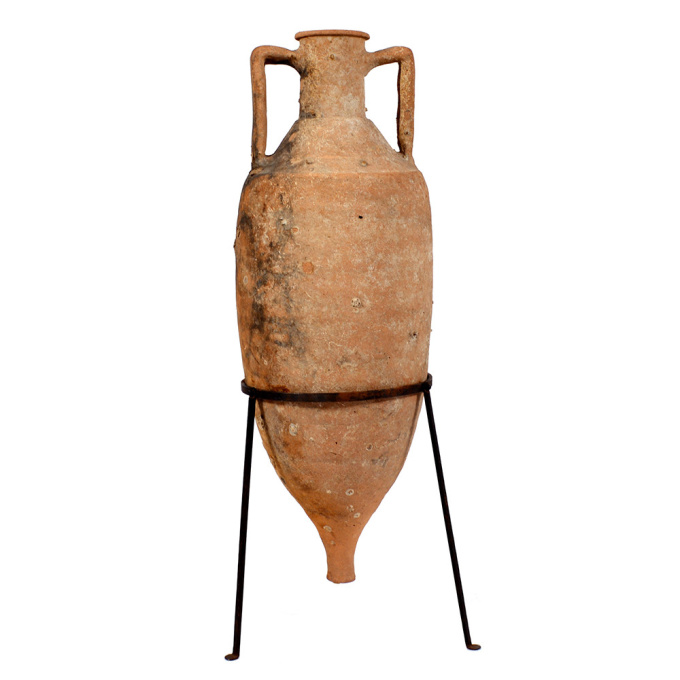Amphore romaine de transport de vin en terre cuite naufragée 100 BC - 100 AD
Artista Sconosciuto
TerracottaCeramica
91 cm
Attualmente non disponibile tramite Gallerease
- A proposito di opere d'arte
This amphora type was based on prototypes from the Aegean island of Cos (Koan type). It has a simple ring-like rim with circular section, and a straight neck ending in a marked shoulder. With a cylindrical body and a solid cylindrical spike. The handles, which comprise two parallel clay shafts with a characteristic bifid section, are flexed and join the amphora immediately below the rim and on the shoulder close to its junction with the neck. With some marine encrustation to one side from long-term underwater exposure, while the other side was most likely submerged in sand and therefore protected. The amphora is fully intact and offered including stand. 91 cm (h) Type: Dressel 2-4 Italian; Koan amphora; Peacock & Williams 10 Ex German private family collection, owned since the 1950s The precise origin of domestic viticulture and winemaking in Rome has not been determined. Early Roman culture was sharply influenced by the ancient Greeks, which makes it likely that the Mycenaean Greeks had some influences in the Roman wine culture through early settlements in southern Italy. Because the ancient Greeks saw wine as a staple of domestic life and a viable economic trade commodity, their settlements were encouraged to plant vineyards for local use and trade. Southern Italy’s abundance of indigenous vines provided an ideal opportunity for wine production Wine had religious, medicinal and social roles that set it apart from other Roman cuisine. Wine, like in Greek culture was mixed with water, and both cultures held banquets, where wine was used to show off wealth and prestige. As Rome entered its golden age of winemaking and the era of expansion, a “democratic” approach to wine started to emerge. Wine was increasingly viewed as a necessity of everyday life rather than simply a luxury enjoyed by the elite. It became available to slaves, peasants and aristocrats, men and women alike. The widespread planting of grapes ensued from the need to serve all classes of society, but was also given impetus by the changing Roman diet. In the 2nd century BC, Romans began to shift from meals consisting of moist porridge and gruel to those more bread-based; wine aided in eating the drier food.
- A proposito di opere artista
Può succedere che un artista o un creatore sia sconosciuto.
Alcune opere non sono determinate da chi sono state realizzate o sono state realizzate da (un gruppo di) artigiani. Esempi sono statue dell'antichità, mobili, specchi o firme non chiare o leggibili ma anche alcune opere non sono affatto firmate.
Inoltre puoi trovare la seguente descrizione:
•"Attribuito a …." A loro avviso probabilmente opera dell'artista, almeno in parte
•“Studio di ….” o “Officina di” A loro avviso un'opera eseguita nello studio o nella bottega dell'artista, eventualmente sotto la sua supervisione
•“Cerchio di…” A loro avviso un'opera del periodo dell'artista che mostra la sua influenza, strettamente legata all'artista ma non necessariamente al suo allievo
•"Stile di..." o "Seguace di..." A loro avviso un'opera eseguita nello stile dell'artista ma non necessariamente da un allievo; può essere contemporaneo o quasi contemporaneo
•“Modalità di…” A loro avviso un'opera nello stile dell'artista ma di epoca successiva
•"Dopo …." A loro avviso una copia (di qualsiasi data) di un'opera dell'artista
•“Firmato…”, “Datato…” o “Iscritto” A loro avviso l'opera è stata firmata/datata/inscritta dall'artista. L'aggiunta di un punto interrogativo indica un elemento di dubbio
•"Con firma....", "Con data...", "Con iscrizione..." o “Riporta firma/data/iscrizione” a loro avviso la firma/data/iscrizione è stata aggiunta da qualcuno diverso dall'artista
Artwork details
Related artworks
- 1 - 4 / 12
Artista Sconosciuto
The bell of the VOC fortress in Jaffna, Sri Lanka1747
Prezzo su richiestaZebregs & Röell - Fine Art - Antiques
 A cura di
A cura diDanny Bree
1 - 4 / 13Klaas II Mobach
Hanna Mobach, daughter of the sculptor Klaas Mobach, reading1950 - 1970
Prezzo su richiestaKunsthandel Pygmalion
1 - 4 / 24

















































